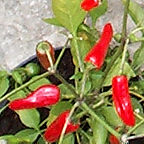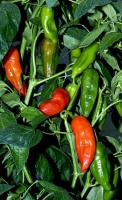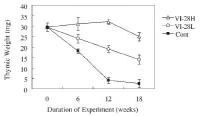-
Content count
4,095 -
Joined
-
Last visited
-
Days Won
19
Posts posted by Auxin
-
-
-
Fuck sake thats expensive!
The RDA for iodine is 150µg per diem for adults, that translates to just about 200µg of potassium iodide.
I got a lifetime supply from a chem supplier on sale for $3, bring on peak oil baby- I'm set!

Since the stuff is so godawful potent I make mine into measured solutions preserved with salt. One bottle is 14% salt and enough KI so 1/4 teaspoon is a days supply and another bottle is 14% salt and a days KI in one tablespoon, which I dilute to 1 cup and drink on days I expect to be sweating a lot of salt out.
Just 5 grams of KI will last an adult 68.5 years
Kelp has a wildly variable iodine content, routinely varying 100 fold in potency.
Iodized salt just doesnt have enough unless you consume too much table salt.
Commercial products with salt in use non-iodized salt.
Do not trust any supplement/vitamin products from the USA. We are notoriously unregulated and random in supplement dosage accuracy. There have even been cases of vitamin D being sold which accidentally contained 10,000,000 units per capsule, and the iodine content of kelp pills has never been regulated here.
-
 4
4
-
-
BC is right, it looks quite a lot like Apache (which is an F1 hybrid) but I dont think it is.
The Daze's chilli has an acutely pointed tip, Apache chillies has a bluntly pointed tip, squint and you can see:
Daze's looks like some sort of Aji to me, the flower coloration would prove it.
It quite reminds me of Aji Verde:
That seems closer, anyway, but Aji Verde is rare.
Look to the Ajis (Capsicum baccatum)
-
 1
1
-
-
-
Now I just need P-Funk to make an album with a background of grasshopper chewing so my medicines will get more potent when the plants hear me saying 'shit god damn'
-
 1
1
-
-
The way I consume raw garlic is to dice it up real fine, mix it with raw HOT chilli peppers, and put that on a pice of bread with some food smeared on top. Garlic provides garlicy goodness, chilli peppers drain the sinuses and release phlegm from the lungs, both stimulate the appetite, and the bread... well thats an edible plate.
"Too much garlic" WTH?
It really is possible to put too much garlic in food
I shit you not!
....but only if you regard coffee as 'food'
-
 2
2
-
-
Well, I'm sure that depends on the listener.
I just find it odd.
This is what real xhosa looks like:

-
 2
2
-
-
...sinicuichi plants , (salicifolia and myrtifolia) like to brought indoors to overwinter from sept/oct here...
Indoors in zone 8? Is that because of all the rain?
Here, in zone 7a, I tried H. salicifolia straight in the ground. It barely survived the first winter and then died in the second. This last winter I couldnt justify bringing them in so I planted the Heimia pots and mulched them with tons of leaves and sprinkled soil on top. They survived the winter and grew without problem when I removed the leaves in spring, the H. myrtifolias sprung back to life a couple weeks quicker. I'll repeat the experiment this year.
...xhosa (silene cap')...
Seriously, how did that nickname ever catch on? Was it a vendor or something?
[Xhosa is the name of the ethnic group that uses that plant so thats like saying "I dont like the word 'Dates', from now on we'll call them 'Arabs'"
 ]
]-
 2
2
-
-
Dont electromagnetic waves from the sun bounce off the moon sort of like sound bounces off a wall and makes an echo?
So the night time electromagnetic signal from the sun would be proportional to the percentage of the moon thats illuminated.
-
 1
1
-
-
A pair of researchers with Stockholm University has discovered a species of Ephedra—a plant that is dependent on the full moon for pollination. In their paper published in The Royal Society Biology Letters, Catarina Rydin and Kristina Bolinder describe how they came upon their findings nearly by accident and the research they conducted afterwards that backed up their suspicions.
To reproduce, plants produce pollen which is carried (by wind, insects, animals, etc.) to other plants of its kind where it fertilizes seeds. As the research pair note, species of Ephedra are pollinated via both insects and the wind, but only one thus far (Ephedra foeminea) prefers pollination by full moonlight. The two made this discovery after a fruitless study of the plants in Greece and Croatia, it hit them that the plants might be waiting for more light from the moon— E. foeminea was already known to be pollinated by nocturnal insects, perhaps they had found they had better luck when there was more moonlight. They returned to the Balkans during the time period when the moon would be full, and found fields that looked like they were full of twinkling diamonds. Intrigued, they returned to Sweden and began studying records of the plant and found a correlation between pollination times for the plants and full moon periods.
E. foeminea, a gymnosperm, produces a clear sugary substance which oozes out of cone-shaped female organs, forming globules. When an insect lands on the globule, it carries with it pollen that sticks to the substance, and eventually the pollen makes its way to a seed at the base of the organ, fertilizing it. The globules, the researchers note, glisten brightly in the full moonlight, attracting insects. They also acknowledge that they have no idea how it is the plants know when the full moon is going to happen, or react when it actually does happen, though they suggest it might be related to the gravitational impact the moon exerts during that time. In any case, the finding is a first for the plant world—no other plant has been found to wait for the full moon to activate a pollinator inducement, including Ephedra distachya, a very close relative, which relies on wind to carry its pollen.-
 6
6
-
-
i think its pretty harsh...2 1/2 years in prison .
I dont think its harsh. For a couple reasons, in concert...
In southeast asia (not just Myanmar) its been illegal to deface images of the buddha for a LONG time. I'm sure you've all seen the cultural meme of a buddha head. The way that came about was theiving foreigners hundreds of years ago went to southeast asia to loot cultural treasures, well whole statues were too heavy to haul out of the jungle and too heavy to ship to england, et al. so these foreign pirates went around the jungles snapping heads off thousand year old buddha statues to take home and sell for $$$. When the people of southeast asia got independence they wanted to stop that shit, and they went one step further and made it illegal to clean your shoes on a buddha statue, etc. as it was a supreme insult to their threatened native culture. This guy didnt get an abnormal sentence, in thailand foreigners are routinely jailed under those laws. Soldiers from my country think its great fun to urinate on a buddha statue and spit beer on pictures of the king. Genuinely apologizing will typically get them out of jail (tho they might have to wait a few months for an audience with the king, lol.)
They act like the guy couldnt have known it was wrong. Well 1, everybody and the fleas on their dog knows that music and getting drunk isnt what the buddha supported, even lay practitioners cant do that when visiting temples. 2, he should have known at least the extreme basic 'its in the damn tour pamphlet' rules of the country. 3, the guy asked someone if it was ok. That means he knew it wasnt and just wanted to see how far he could legally offend people.
With how much the west has savaged those countries can you blame them for wanting a bit of respect?
as if buddha would give a fuck
 [because the Buddha was celibate]
[because the Buddha was celibate]the Buddha would cringe if he saw the way his images are worshipped today in place of his teachings.
Its an interesting historical point that in the Buddhas life and for hundreds of years after his death no image of the buddha was made.
The most ancient strata of stone carvings would represent him as a tree (for enlightenment), or a set of footprints (for the jhanas), I think there are a few that use a flame (for the teaching he gave to fire worshipers). So its a bit ironic that people worship the image, particularly since he didnt look like that (the suttas make it very clear he was clean shaven- the baby dreadlocks were to impress vedic scholars who thought that was a sign of 'an auspicious man. Another sign is a foreskin that fully covers the head of the penis, be glad the statue has a robe) he also didnt have that bun on his head, its a vestigial turban from the imported greek sculptors that started the statue tradition).
-
 3
3
-
-
But can you get high by rubbing it on your nipples?
I did that with some really crystally bud once, it was awesome just for the novelty of the innovation.
Not often one gets to do something with drugs that borders on the avantgarde.
-
 4
4
-
-
I wonder how flammable it is.
I dont drink, but I might be willing to play with fire in unwise ways

-
 5
5
-
-
Yeah, the researchers indicated that they intend to modify harmine to still work but without the RIMA/psychoactive effect. But lets be honest, they intend to modify it for a patent.
When used correctly the RIMA thing is a non-issue, particularly since this isnt an emergency-medicine context- people would have advanced warning.
I hope some day we see dosage and efficacy trials with harmine itself so people outside of wealthy nations will better benefit from it.
Perhaps Iran could do a trial with esphand, they've been doing a fair number of pharmacognosy trials lately.
-
 2
2
-
-
If you squint you can see mescaline, lol
 Research shows Asian herb holds promise as treatment for Ebola virus disease
Research shows Asian herb holds promise as treatment for Ebola virus diseaseNew research that focuses on the mechanism by which Ebola virus infects a cell and the discovery of a promising drug therapy candidate is being published February 27, 2015, in the journal Science. Dr. Robert Davey, scientist and Ewing Halsell Scholar in the Department of Immunology and Virology at Texas Biomedical Research Institute announced today that a small molecule called Tetrandrine derived from an Asian herb has shown to be a potent small molecule inhibiting infection of human white blood cells in vitro or petri dish experiments and prevented Ebola virus disease in mice.
The latest outbreak of Ebola virus disease has caused the death of more than 9,400 people worldwide and created an international crisis that has shown few signs of stopping, continuing to infect thousands in West Africa. Ebola virus causes hemorrhagic fever in humans and currently has no approved therapy or vaccine. Scientists at Texas Biomed have been working in the Institute's Biosafety Level 4 containment laboratory for more than 10 years to find a vaccine, therapies and detection methods for the virus.
Davey and his team have been working for more than five years on identifying and finding therapy targets for Ebola virus disease. Davey's research has focused on stopping the virus before it has a chance to enter or interact with cellular factors, as that is a critical first step to combatting infection.
Ebola virus begins its entry into a cell by first binding to several types of cell surface proteins. Then the virus is taken into the cell and follows an endosomal route, or membrane-bound route that transports the virus to various cell compartments.
From previous studies, Davey said that during this endosomal process, he knew that calcium signaling in cells, which allow cells to transmit electrical charges to one another, controls many of the processes in the cell and was important for Ebola virus infection.
"We were not able, however, to pinpoint the mechanisms involved in this process," Davey explained. "With this research, we discovered that two pore channels (TPCs) are the key calcium sensor involved in Ebola virus infection. These TPCs essentially need to be turned on in order for the virus to function properly."
Two pore channels are unusual calcium channels found in endosomes that control the way endosomes move through cells and the environment of the cells. Davey compared TPCs to traffic cops and air conditioners, helping direct the endosomes and any virus it might be carrying through the cell and making the endosomes and its passengers more comfortable along the way.
Davey and his team were able to show the critical role of two pore channels in Ebola virus infection, which has not previously been shown in any other virus.
In addition to identifying this critical mechanism to infection, Davey's team also showed that drugs targeting this interaction show some efficacy as potential treatments against Ebola virus disease.
In the study, Davey's team determined that existing drugs currently used to treat high blood pressure have an ability to turn this key calcium sensor on and off. Working with a group in Munich, Germany and Southwest Research Institute, the team tested several small molecules to see which was most effective at turning the sensors off thus prohibiting Ebola virus from moving any further through the cell.
The team found Tetrandrine protected mice from disease without obvious side effects and was the best candidate for further animal testing, because it was the most potent compound tested, gave little evidence of cytotoxicity and required a smaller dose to be effective and tolerated.
"When we tested in mice, the drugs stopped virus replication and saved most of them from disease," Davey said.
Essentially, this drug shows an ability to stop the virus before it has a chance interact with cellular factors, thus stopping the virus from continuing its infection process.
"We are very excited about the progress made in this study and the momentum it provides as scientists across the world vigorously search for effective vaccines and treatments against Ebola virus," Davey said. "We are cautiously optimistic. The next step in the process is to test both safety and effectiveness of the interaction of the drug with Ebola virus in non-human primates."Luckily I've just been reading the pharmacopoea of the peoples republic so I recognized the chem. The herb that they annoyingly didnt name is Stephania tetrandra, its dried root is 1-2% tetrandrine. Be cautious with commercial sources as its often switched with kidney destroying Aristolochia species.
-
 1
1
-
-
Not surprising.
The process over here is quite standardized: doctors cycle patients through different antidepressants until they coincidentally start feeling better, the doctor takes the credit and insists the patient stay on the drug, the patient gets heavily addicted, the patient gets the stress of being chained to the drug for years or decades until they die or have the strength to spend months in drug withdrawals.
I've seen it in many people, even young children (its not rare for 5-8 year olds to be on antidepressants here and some infants are put on them)
-
 2
2
-
-
... Arctium lappa (Burdock root)
That has a yearly spot in my garden, quite useful.
I grow the roots MUCH bigger than the japanese do, like 5 cm x 22 cm, and theyre still perfectly edible cooked. The leaves are edible, theres a 'edible leaf' variety called ha gobo but fuck it, I just eat the normal ones cooked. It has various medicinal properties- the root is used as a detoxifier in the west and is packed with antioxidants and novel critters, the leaves have the antioxidants without the novel critters, the seed is used for head, neck, and upper respiratory infections in asia- packed with lignans and others.
First time I grew it I got it in trade from a wild harvester and it tasted like shit tho. It became a vegetable after I bought medicinal grade seed.
-
One example of the seemingly sparse research into herbal reduction of thymic involution investigated a compound chinese preparation which included such things as Panax ginseng, Cervus nippon, Cordyceps sinensis, Salvia miltiorrhiza, Allium tuberosum, Cnidium monnieri, cervi pantotrichum, and Euodia rutaecarpa.
The 'Yang'-promoting traditional Chinese medicines (TCM) are used to boost vigor and enhance immunity in humans. In this study, the immunopotentiating effect of VI-28, a 'Yang'-promoting TCM formula containing extracts of radix ginseng, cornu Cervi pantotrichum and radix Salvia miltiorrhizae, was investigated. Groups of 8-month-old female ex-breeder BALB/c mice were fed on ordinary mouse food or food containing a low (0.5%) or high (2%) dose VI-28 for up to 18 weeks. From week 6, mice on the TCM-containing diet were much healthier, stronger and more alert than those on the normal mouse food. Furthermore, their thymuses were significantly bigger and heavier than those of the control mice. Histological examination revealed structural changes typical of thymic involution in mice of the control group, whilst the microstructure of thymuses from mice taking TCM-containing food was comparable to that of mice of a much younger age, indicating a positive effect of VI-28 on slowing down thymic involution. Functional analysis of splenocytes from mice of different groups suggested that oral administration of VI-28 corrected the hyporesponsiveness of T lymphocytes in aged mice. These results have important implications for our understanding of the mechanisms of the immunoboosting effect of TCM.
You can see the effect of Low and High doses on thymus weight and improved thymic weight increased peripheral T-cell responsiveness.
They didnt explicitly hazard a guess as to which components were most likely to be responsible tho.
-
 1
1
-
-
You can, but why would you? It slows growth.
Usually the grafts with no leaves lost their leaves when they went too long without being watered. Pereskiopsis is nearly an aquatic plant, lol
-
 2
2
-
-
I'm curious if anyone has looked into this topic and could point to (scientifically supported) promising planty lines of research in slowing thymic involution or outright reversing it. I've been intending to look into this for years and have finally started building a pile of research crap to get me started.
[Thymic involution is a process of gradual loss of functional cells in the thymus gland which are responsible for maturing naive T-cells from the bone marrow so they can go out and mount new immune defenses. The thymus shrinks from age 1 until death and this shrinkage is why people get less and less able to resist novel infections after the age of 65 or so.]
I want to have a good immune system when I'm 85

-
 1
1
-
-
The UV-C killed most and of the survivors a few looked nice and tortured for a year or three but then they just became normal looking cacti.
I may not have done enough seedlings. Did a few dozen when I should have done a thousand, lol
-
 1
1
-
-
The article reminds me of one I read about american vitamin supplements, especially this bit:
"You might think that a more expensive fish oil is less likely to be degraded, that is not the case, there is no relationship with price."
The drug levels in american vitamins were more or less random, tending toward underdosing, with no correlation to price (and some american vitamins are absurdly expensive).
Moral is, never blindly trust a government to be working hard to do their job.
By default assume all products are poorly regulated and rarely tested, if tested at all.
-
 3
3
-
-
Yup.
The title of the actual study in question is Ritual circumcision and risk of autism spectrum disorder in 0- to 9-year-old boys: national cohort study in Denmark. In it they found an overall increase in risk of 46% and among infantile autism cases the risk increased by 106%, thats more than double. In muslim families hyperkinetic disorder risk increased 81%. So the effect is substantial.
In regards to 342,877 people being too small of a statistical pool for meaningful analysis (lol) the statistical analysis showed a 1 in 1000 chance that the correlation was not a genuine one. That means do the study 1000 times and, statistically, one of them would give a wrong result. Many studies linking arsenic or smoking to harm didnt get such a sound statistical confirmation.
Overall I still dont quite know what to make of this study tho, further research into mechanism and context of the effect should prove quite interesting.
Watch them surprise all of us further by finding some foreskin bacteria that prevents autism, opening the door to a crafty korean food manufacturer producing anti-autism kimchee.
-
 3
3
-
-
Autism is not sex selective so how can it be related to circumcision.
Quite simply, really. As they said - among boys circumcision increases risk. They didnt propose that it was the only possible cause or trigger, they didnt even directly state that it was a cause but just that it increases risk.
Oh, and autism is sex selective. 43 ASD boys for each 10 girls [before splitting into sub-groups].








Homophobes are psychotic and immature
in Chill Space
Posted
Its now official, peer reviewed clinical medicine has diagnosed homophobes as being psychotic and immature
[Link]
I love how the immature correlation managed to score a P